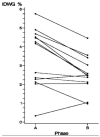Individualized reduction in dialysate sodium in conventional in-center hemodialysis
- PMID: 22554224
- PMCID: PMC3660723
- DOI: 10.1111/j.1542-4758.2012.00701.x
Individualized reduction in dialysate sodium in conventional in-center hemodialysis
Abstract
Recent studies have focused on the association between dialysate sodium (Na(+)) prescriptions and interdialytic weight gain (IDWG). We report on a case series of 13 patients undergoing conventional, thrice-weekly in-center hemodialysis with an individualized dialysate Na(+) prescription. Individualized dialysate Na(+) was achieved in all patients through a stepwise weekly reduction of the standard dialysate Na(+) prescription (140 mEq/L) by 2-3 mEq/L until reaching a Na(+) gradient of -2 mEq/L (dialysate Na(+) minus average plasma Na(+) over the preceding 3 months). Interdialytic weight gain, with and without indexing to dry weight (IDWG%), blood pressure, and the proportion of treatments with cramps, intradialytic hypotension (drop in systolic blood pressure >30 mmHg) and intradialytic hypotension requiring an intervention were reviewed. At the beginning of the observation period, the pre-hemodialysis (HD) plasma Na(+) concentration ranged from 130 to 141 mEq/L. When switched from the standard to the individualized dialysate Na(+) concentration, IDWG% decreased from 3.4% ± 1.6% to 2.5% ± 1.0% (P = 0.003) with no change in pre- or post-HD systolic or diastolic blood pressures (all P > 0.05). We found no significant change in the proportion of treatments with cramps (6% vs. 13%), intradialytic hypotension (62% vs. 65%), or intradialytic hypotension requiring an intervention (29% vs. 33%). Individualized reduction of dialysate Na(+) reduces IDWG% without significantly increasing the frequency of cramps or hypotension.
© 2012 The Authors. Hemodialysis International © 2012 International Society for Hemodialysis.
Figures
Similar articles
-
Clinical consequences of an individualized dialysate sodium prescription in hemodialysis patients.Kidney Int. 2004 Sep;66(3):1232-8. doi: 10.1111/j.1523-1755.2004.00876.x. Kidney Int. 2004. PMID: 15327422 Clinical Trial.
-
Effect of lowering dialysate sodium concentration on interdialytic weight gain and blood pressure in patients undergoing thrice-weekly in-center nocturnal hemodialysis: a quality improvement study.Am J Kidney Dis. 2011 Dec;58(6):956-63. doi: 10.1053/j.ajkd.2011.06.030. Epub 2011 Aug 27. Am J Kidney Dis. 2011. PMID: 21875769 Free PMC article. Clinical Trial.
-
Individualized dialysate sodium prescriptions using sodium gradients for high-risk hemodialysis patients lowered interdialytic weight gain and achieved target weights.Hemodial Int. 2020 Jul;24(3):406-413. doi: 10.1111/hdi.12830. Epub 2020 Mar 5. Hemodial Int. 2020. PMID: 32141198
-
The efficacy and safety of low dialysate sodium levels for patients with maintenance haemodialysis: A systematic review and meta-analysis.Int J Surg. 2020 Jul;79:332-339. doi: 10.1016/j.ijsu.2020.05.027. Epub 2020 May 21. Int J Surg. 2020. PMID: 32447003
-
Dialysate sodium and intradialytic hypotension.Semin Dial. 2017 Nov;30(6):492-500. doi: 10.1111/sdi.12634. Epub 2017 Jul 13. Semin Dial. 2017. PMID: 28707302 Review.
Cited by
-
Rationale and design of the Sodium Lowering In Dialysate (SoLID) trial: a randomised controlled trial of low versus standard dialysate sodium concentration during hemodialysis for regression of left ventricular mass.BMC Nephrol. 2013 Jul 15;14:149. doi: 10.1186/1471-2369-14-149. BMC Nephrol. 2013. PMID: 23855560 Free PMC article. Clinical Trial.
-
The relationship of volume overload and its control to hypertension in hemodialysis patients.Semin Dial. 2019 Nov;32(6):500-506. doi: 10.1111/sdi.12838. Epub 2019 Sep 29. Semin Dial. 2019. PMID: 31564065 Free PMC article. Review.
-
Executive Summary of the Korean Society of Nephrology 2021 Clinical Practice Guideline for Optimal Hemodialysis Treatment.Kidney Res Clin Pract. 2021 Dec;40(4):578-595. doi: 10.23876/j.krcp.21.700. Epub 2021 Dec 10. Kidney Res Clin Pract. 2021. PMID: 34922430 Free PMC article.
-
Definitions of intradialytic hypotension.Semin Dial. 2017 Nov;30(6):464-472. doi: 10.1111/sdi.12626. Epub 2017 Jul 9. Semin Dial. 2017. PMID: 28691195 Free PMC article.
-
Epidemiology, diagnosis and management of hypertension among patients on chronic dialysis.Nat Rev Nephrol. 2016 Oct;12(10):636-47. doi: 10.1038/nrneph.2016.129. Epub 2016 Aug 30. Nat Rev Nephrol. 2016. PMID: 27573731 Review.
References
-
- Ok E, Mees EJ. Unpleasant truths about salt restriction. Semin Dial. 2010;23:1–3. - PubMed
-
- Penne EL, Levin NW, Kotanko P. Improving volume status by comprehensive dietary and dialytic sodium management in chronic hemodialysis patients. Blood Purif. 2010;30:71–78. - PubMed
-
- de Paula FM, Peixoto AJ, Pinto LV, Dorigo D, Patricio PJ, Santos SF. Clinical consequences of an individualized dialysate sodium prescription in hemodialysis patients. Kidney Int. 2004;66:1232–1238. - PubMed
-
- Flanigan MJ. How should dialysis fluid be Individualized for the chronic hemodialysis patient? Sodium. Semin Dial. 2008;21:226–229. - PubMed
Publication types
MeSH terms
Substances
Grants and funding
LinkOut - more resources
Full Text Sources
Medical



